Francesca Dominici
Algorithmic Collective Action with Multiple Collectives
Aug 26, 2025Abstract:As learning systems increasingly influence everyday decisions, user-side steering via Algorithmic Collective Action (ACA)-coordinated changes to shared data-offers a complement to regulator-side policy and firm-side model design. Although real-world actions have been traditionally decentralized and fragmented into multiple collectives despite sharing overarching objectives-with each collective differing in size, strategy, and actionable goals, most of the ACA literature focused on single collective settings. In this work, we present the first theoretical framework for ACA with multiple collectives acting on the same system. In particular, we focus on collective action in classification, studying how multiple collectives can plant signals, i.e., bias a classifier to learn an association between an altered version of the features and a chosen, possibly overlapping, set of target classes. We provide quantitative results about the role and the interplay of collectives' sizes and their alignment of goals. Our framework, by also complementing previous empirical results, opens a path for a holistic treatment of ACA with multiple collectives.
Directed Semi-Simplicial Learning with Applications to Brain Activity Decoding
May 23, 2025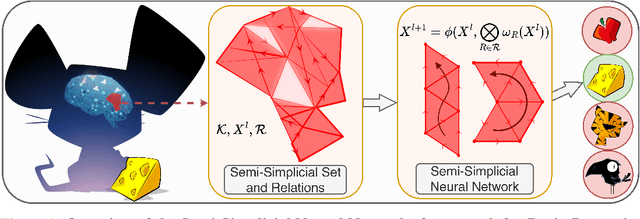
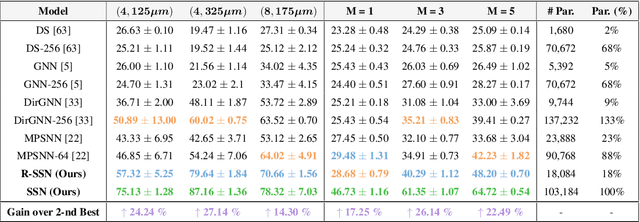

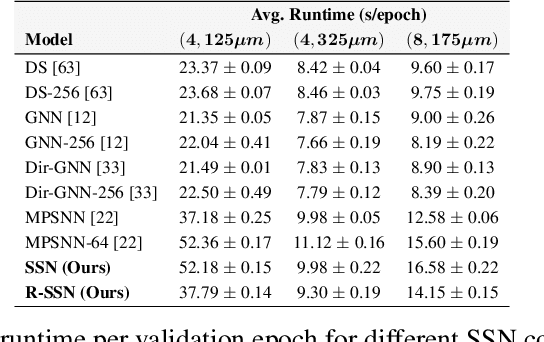
Abstract:Graph Neural Networks (GNNs) excel at learning from pairwise interactions but often overlook multi-way and hierarchical relationships. Topological Deep Learning (TDL) addresses this limitation by leveraging combinatorial topological spaces. However, existing TDL models are restricted to undirected settings and fail to capture the higher-order directed patterns prevalent in many complex systems, e.g., brain networks, where such interactions are both abundant and functionally significant. To fill this gap, we introduce Semi-Simplicial Neural Networks (SSNs), a principled class of TDL models that operate on semi-simplicial sets -- combinatorial structures that encode directed higher-order motifs and their directional relationships. To enhance scalability, we propose Routing-SSNs, which dynamically select the most informative relations in a learnable manner. We prove that SSNs are strictly more expressive than standard graph and TDL models. We then introduce a new principled framework for brain dynamics representation learning, grounded in the ability of SSNs to provably recover topological descriptors shown to successfully characterize brain activity. Empirically, SSNs achieve state-of-the-art performance on brain dynamics classification tasks, outperforming the second-best model by up to 27%, and message passing GNNs by up to 50% in accuracy. Our results highlight the potential of principled topological models for learning from structured brain data, establishing a unique real-world case study for TDL. We also test SSNs on standard node classification and edge regression tasks, showing competitive performance. We will make the code and data publicly available.
Quantum Simplicial Neural Networks
Jan 09, 2025



Abstract:Graph Neural Networks (GNNs) excel at learning from graph-structured data but are limited to modeling pairwise interactions, insufficient for capturing higher-order relationships present in many real-world systems. Topological Deep Learning (TDL) has allowed for systematic modeling of hierarchical higher-order interactions by relying on combinatorial topological spaces such as simplicial complexes. In parallel, Quantum Neural Networks (QNNs) have been introduced to leverage quantum mechanics for enhanced computational and learning power. In this work, we present the first Quantum Topological Deep Learning Model: Quantum Simplicial Networks (QSNs), being QNNs operating on simplicial complexes. QSNs are a stack of Quantum Simplicial Layers, which are inspired by the Ising model to encode higher-order structures into quantum states. Experiments on synthetic classification tasks show that QSNs can outperform classical simplicial TDL models in accuracy and efficiency, demonstrating the potential of combining quantum computing with TDL for processing data on combinatorial topological spaces.
Towards a Health-Based Power Grid Optimization in the Artificial Intelligence Era
Oct 11, 2024
Abstract:The electric power sector is one of the largest contributors to greenhouse gas emissions in the world. In recent years, there has been an unprecedented increase in electricity demand driven by the so-called Artificial Intelligence (AI) revolution. Although AI has and will continue to have a transformative impact, its environmental and health impacts are often overlooked. The standard approach to power grid optimization aims to minimize CO$_2$ emissions. In this paper, we propose a new holistic paradigm. Our proposed optimization directly targets the minimization of adverse health outcomes under energy efficiency and emission constraints. We show the first example of an optimal fuel mix allocation problem aiming to minimize the average number of adverse health effects resulting from exposure to hazardous air pollutants with constraints on the average and marginal emissions. We argue that this new health-based power grid optimization is essential to promote truly sustainable technological advances that align both with global climate goals and public health priorities.
Higher-Order Topological Directionality and Directed Simplicial Neural Networks
Sep 12, 2024
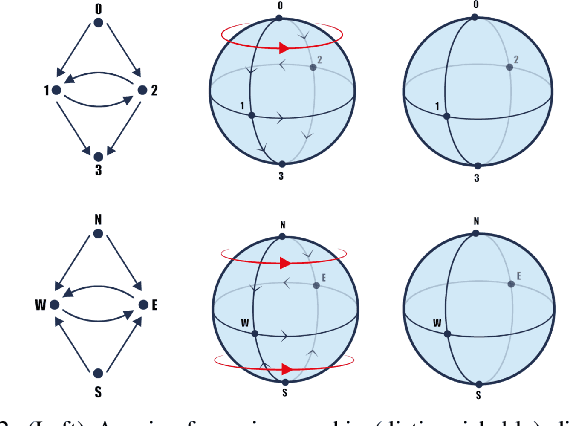


Abstract:Topological Deep Learning (TDL) has emerged as a paradigm to process and learn from signals defined on higher-order combinatorial topological spaces, such as simplicial or cell complexes. Although many complex systems have an asymmetric relational structure, most TDL models forcibly symmetrize these relationships. In this paper, we first introduce a novel notion of higher-order directionality and we then design Directed Simplicial Neural Networks (Dir-SNNs) based on it. Dir-SNNs are message-passing networks operating on directed simplicial complexes able to leverage directed and possibly asymmetric interactions among the simplices. To our knowledge, this is the first TDL model using a notion of higher-order directionality. We theoretically and empirically prove that Dir-SNNs are more expressive than their directed graph counterpart in distinguishing isomorphic directed graphs. Experiments on a synthetic source localization task demonstrate that Dir-SNNs outperform undirected SNNs when the underlying complex is directed, and perform comparably when the underlying complex is undirected.
E(n) Equivariant Topological Neural Networks
May 24, 2024Abstract:Graph neural networks excel at modeling pairwise interactions, but they cannot flexibly accommodate higher-order interactions and features. Topological deep learning (TDL) has emerged recently as a promising tool for addressing this issue. TDL enables the principled modeling of arbitrary multi-way, hierarchical higher-order interactions by operating on combinatorial topological spaces, such as simplicial or cell complexes, instead of graphs. However, little is known about how to leverage geometric features such as positions and velocities for TDL. This paper introduces E(n)-Equivariant Topological Neural Networks (ETNNs), which are E(n)-equivariant message-passing networks operating on combinatorial complexes, formal objects unifying graphs, hypergraphs, simplicial, path, and cell complexes. ETNNs incorporate geometric node features while respecting rotation and translation equivariance. Moreover, ETNNs are natively ready for settings with heterogeneous interactions. We provide a theoretical analysis to show the improved expressiveness of ETNNs over architectures for geometric graphs. We also show how several E(n) equivariant variants of TDL models can be directly derived from our framework. The broad applicability of ETNNs is demonstrated through two tasks of vastly different nature: i) molecular property prediction on the QM9 benchmark and ii) land-use regression for hyper-local estimation of air pollution with multi-resolution irregular geospatial data. The experiment results indicate that ETNNs are an effective tool for learning from diverse types of richly structured data, highlighting the benefits of principled geometric inductive bias.
Optimizing Heat Alert Issuance for Public Health in the United States with Reinforcement Learning
Dec 21, 2023
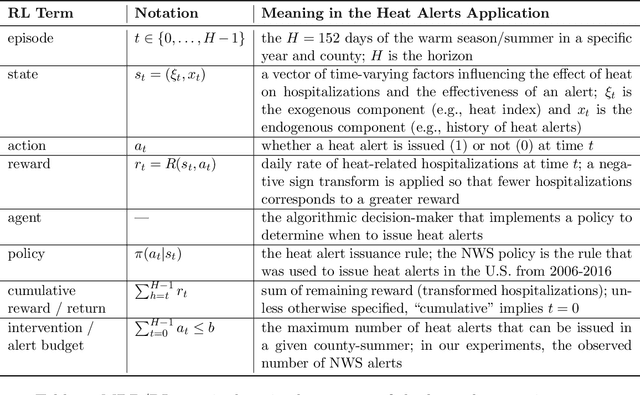
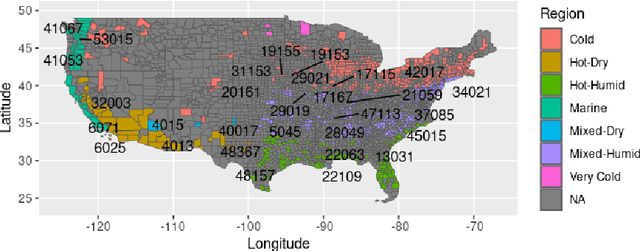

Abstract:Alerting the public when heat may harm their health is a crucial service, especially considering that extreme heat events will be more frequent under climate change. Current practice for issuing heat alerts in the US does not take advantage of modern data science methods for optimizing local alert criteria. Specifically, application of reinforcement learning (RL) has the potential to inform more health-protective policies, accounting for regional and sociodemographic heterogeneity as well as sequential dependence of alerts. In this work, we formulate the issuance of heat alerts as a sequential decision making problem and develop modifications to the RL workflow to address challenges commonly encountered in environmental health settings. Key modifications include creating a simulator that pairs hierarchical Bayesian modeling of low-signal health effects with sampling of real weather trajectories (exogenous features), constraining the total number of alerts issued as well as preventing alerts on less-hot days, and optimizing location-specific policies. Post-hoc contrastive analysis offers insights into scenarios when using RL for heat alert issuance may protect public health better than the current or alternative policies. This work contributes to a broader movement of advancing data-driven policy optimization for public health and climate change adaptation.
SpaCE: The Spatial Confounding Environment
Dec 06, 2023Abstract:Spatial confounding poses a significant challenge in scientific studies involving spatial data, where unobserved spatial variables can influence both treatment and outcome, possibly leading to spurious associations. To address this problem, we introduce SpaCE: The Spatial Confounding Environment, the first toolkit to provide realistic benchmark datasets and tools for systematically evaluating causal inference methods designed to alleviate spatial confounding. Each dataset includes training data, true counterfactuals, a spatial graph with coordinates, and smoothness and confounding scores characterizing the effect of a missing spatial confounder. It also includes realistic semi-synthetic outcomes and counterfactuals, generated using state-of-the-art machine learning ensembles, following best practices for causal inference benchmarks. The datasets cover real treatment and covariates from diverse domains, including climate, health and social sciences. SpaCE facilitates an automated end-to-end pipeline, simplifying data loading, experimental setup, and evaluating machine learning and causal inference models. The SpaCE project provides several dozens of datasets of diverse sizes and spatial complexity. It is publicly available as a Python package, encouraging community feedback and contributions.
Causal Shift-Response Functions with Neural Networks: The Health Benefits of Lowering Air Quality Standards in the US
Feb 06, 2023Abstract:Policymakers are required to evaluate the health benefits of reducing the National Ambient Air Quality Standards (NAAQS; i.e., the safety standards) for fine particulate matter PM 2.5 before implementing new policies. We formulate this objective as a shift-response function (SRF) and develop methods to analyze the problem using methods for causal inference, specifically under the stochastic interventions framework. SRFs model the average change in an outcome of interest resulting from a hypothetical shift in the observed exposure distribution. We propose a new broadly applicable doubly-robust method to learn SRFs using targeted regularization with neural networks. We evaluate our proposed method under various benchmarks specific for marginal estimates as a function of continuous exposure. Finally, we implement our estimator in the motivating application that considers the potential reduction in deaths from lowering the NAAQS from the current level of 12 $\mu g/m^3$ to levels that are recently proposed by the Environmental Protection Agency in the US (10, 9, and 8 $\mu g/m^3$).
Causal Rule Ensemble: Interpretable Inference of Heterogeneous Treatment Effects
Sep 18, 2020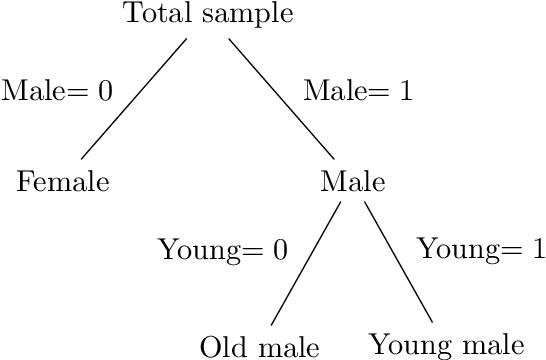
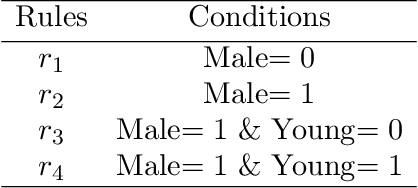
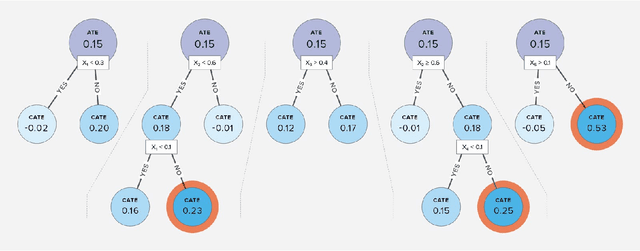

Abstract:In environmental epidemiology, it is critically important to identify subpopulations that are most vulnerable to the adverse effects of air pollution so we can develop targeted interventions. In recent years, there have been many methodological developments for addressing heterogeneity of treatment effects in causal inference. A common approach is to estimate the conditional average treatment effect (CATE) for a pre-specified covariate set. However, this approach does not provide an easy-to-interpret tool for identifying susceptible subpopulations or discover new subpopulations that are not defined a priori by the researchers. In this paper, we propose a new causal rule ensemble (CRE) method with two features simultaneously: 1) ensuring interpretability by revealing heterogeneous treatment effect structures in terms of decision rules and 2) providing CATE estimates with high statistical precision similar to causal machine learning algorithms. We provide theoretical results that guarantee consistency of the estimated causal effects for the newly discovered causal rules. Furthermore, via simulations, we show that the CRE method has competitive performance on its ability to discover subpopulations and then accurately estimate the causal effects. We also develop a new sensitivity analysis method that examine robustness to unmeasured confounding bias. Lastly, we apply the CRE method to the study of the effects of long-term exposure to air pollution on the 5-year mortality rate of the New England Medicare-enrolled population in United States. Code is available at https://github.com/kwonsang/causal_rule_ensemble.
 Add to Chrome
Add to Chrome Add to Firefox
Add to Firefox Add to Edge
Add to Edge